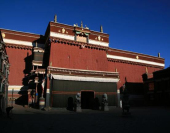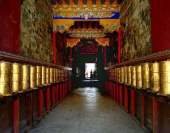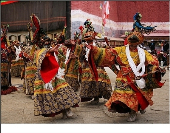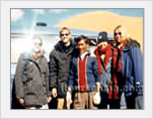
Sakya Monastery Guide
-Travel to Sakya Monastery The artistic precious items in Sakya Monastery are of volumi-nousness and high cultural relic value; therefore, it is called the Second Dunhuang. Sakya Monastery is located by the two banks of the Drongchu River and on the ridge of the Bonbo mountain in Sakya county, in the Tibetan region of Tsang, about one hundred miles north of the border between Tibet and Nepal, about 160 km to the west of Shigatse. The region is unique for its gray (kya) earth (sa), hence the name Sakya. From 1073 until 1959, this monastery served as the seat of the Sakya Order and of the Sakya Trizins who are the spiritual leaders of the order. It comprises the south and north monasteries. The north monastery was built in 1079 and the southern in 1268. In 1268 Chogyal Phagpa, the fifth of the five founders of the Sakya Order, greatly expanded the monastery, and over the centuries it has grown into a complex of hundreds of temples, shrines, and monastic residences.
The artistic precious items in Sakya Monastery are of volumi-nousness and high cultural relic value; therefore, it is called the Second Dunhuang. Sakya Monastery is located by the two banks of the Drongchu River and on the ridge of the Bonbo mountain in Sakya county, in the Tibetan region of Tsang, about one hundred miles north of the border between Tibet and Nepal, about 160 km to the west of Shigatse. The region is unique for its gray (kya) earth (sa), hence the name Sakya. From 1073 until 1959, this monastery served as the seat of the Sakya Order and of the Sakya Trizins who are the spiritual leaders of the order. It comprises the south and north monasteries. The north monastery was built in 1079 and the southern in 1268. In 1268 Chogyal Phagpa, the fifth of the five founders of the Sakya Order, greatly expanded the monastery, and over the centuries it has grown into a complex of hundreds of temples, shrines, and monastic residences.
 There are large collections of historical cultural objects in the monastery, such as appointment letters, jade seals, crown, gown given to the officials of local Sakya admin-sitration by the central government of Yuan Dynasty, statues, religious articles and porcelains from Sung and Yuan dynasties as well as precious mural paintings and etc. And the buildings contain thousands of statues, paintings, murals, stupas, mandalas, and other holy objects, as well as libraries of scriptures in Tibetan, Chinese, Mongolian, and Sanskrit piled from floor to ceiling. Among the holy objects in the monastery are the lifesize statue of Manjushri that spoke to Sakya Pandita to assist him during a famous debate; a small statue of Tara that was Atisha’s personal meditation object; and the conch shell blown by the Buddha’s disciples to summon monks to his teachings. Sakya Monastery became a citadel of learning and the fount from which the ten major and minor sciences were introduced to Tibet from India.
There are large collections of historical cultural objects in the monastery, such as appointment letters, jade seals, crown, gown given to the officials of local Sakya admin-sitration by the central government of Yuan Dynasty, statues, religious articles and porcelains from Sung and Yuan dynasties as well as precious mural paintings and etc. And the buildings contain thousands of statues, paintings, murals, stupas, mandalas, and other holy objects, as well as libraries of scriptures in Tibetan, Chinese, Mongolian, and Sanskrit piled from floor to ceiling. Among the holy objects in the monastery are the lifesize statue of Manjushri that spoke to Sakya Pandita to assist him during a famous debate; a small statue of Tara that was Atisha’s personal meditation object; and the conch shell blown by the Buddha’s disciples to summon monks to his teachings. Sakya Monastery became a citadel of learning and the fount from which the ten major and minor sciences were introduced to Tibet from India.
 The fame of Sakya Monastery and its teachers reached the ears of Kublai Khan and Godan Khan, the Mongol rulers of China. They invited Sakya Pandita, who was the fourth of the five founders, and Chogyal Phagpa to their court. Through the teachings of these two great masters, Vajrayana Buddhism reached China. Under the leadership of His Holiness Sakya Trizin, major portions of Sakya Monastery that were destroyed during the Cultural Revolution have been renovated, and religious activities still continue there as they have for nearly a thousand years.
The fame of Sakya Monastery and its teachers reached the ears of Kublai Khan and Godan Khan, the Mongol rulers of China. They invited Sakya Pandita, who was the fourth of the five founders, and Chogyal Phagpa to their court. Through the teachings of these two great masters, Vajrayana Buddhism reached China. Under the leadership of His Holiness Sakya Trizin, major portions of Sakya Monastery that were destroyed during the Cultural Revolution have been renovated, and religious activities still continue there as they have for nearly a thousand years.
More Attractions in The Tibet
- The Potala Palace
- The Sera Monastery
- The Norbulingka
- The Jokhang Temple
- The Barkhor Street
- The Tibet Museum
- The Tibetan Traditional Hospital
- The New Palace of Panchen
- The Drepung Monastery
- Yamdrok Yumtso Lake
- Tashilhunpo Monastery
- Gyangtse Old Street
- Yangpachen
- Lake Namtso
- Songtsen Gampo
- Himalayan Ranges
- Palkhor Monastery
- Lhasa Carpet Factory
- Everest Base Camp
- Rongbuk Monastery
- Sakya Monastery
Your Question & Quick Answer*We welcome and appreciate your questions & reviews
Booking Procedures | Terms & Conditions | Payment Methods | Links | Site Map | About Us | Contact Us | Travel Agent
Copyright 2008, All rights reserved.. itourbeijing.com professional china travel guide and china travel service
TEL: 86-10-85711972 (Universal) 1-888-288-9328 (North America) E-mail: contact@itourbeijng.com
Tours Index | China Tours | Beijing Tours | Xi'an Tours | Shanghai Tours | Guilin Tours | Tibet Tours
China Travel | Beijing Travel | Shanghai Travel | Xi'an Travel | Guilin Travel |Beijing Map
China Golf | Beijing Golf | Shanghai Golf | Xiamen Golf | The Great Wall Travel | Yangtze Cruise | Travel Picture



